News
Facing Stronger North Korean Air Defences: U.S. Makes First F-35 Deployment to South in Half a Decade
On July 11 six United States Air Force F-35A stealth fighters arrived in South Korea, which marked the first such deployment of the aircraft since 2017. The deployments closely follow tests of a range of new advanced tactical weapons by North Korea’s armed forces, and the inauguration of a new administration in Seoul that is expected to align the country much more closely with Washington and against both Pyongyang and its largest trading partner Beijing. The F-35 is the only fifth generation fighter in production in the Western world, and one of just two of its generation in production to be fielded at squadron level strength alongside the Chinese J-20. The aircraft was developed under the Joint Strike Fighter program, the name of which reflects its primary purpose of air to ground operations with air to air capabilities remaining secondary and primarily defensive. This makes the fighter particularly well suited to the Korean Peninsula, where Western drafted embargoes passed through the United Nations Security Council have prevented North Korea from importing modern combat aircraft meaning the need for air to air capabilities is more limited.
North Korea’s ground based air defence network is considered a far greater challenge to U.S. or allied efforts to launch an assault on the country, with multiple new systems having been unveiled since the mid 2010s including long ranged mobile platforms analogous to the Russian S-300/400 series. Pyongyang and Washington have been technically at war for over 70 years, and North Korean military modernisation efforts have been aimed overwhelmingly at preparing for a potential conflict with the United States Military and its allies. Since the Cold War such efforts have focused particularly on the development of asymmetric assets, with the most recent breakthrough being the development of hypersonic glide vehicles for its ballistic missiles which it was the third country to achieve after Russia and China.

North Korea’s fighter fleet is comprised primarily of third generation MiG-23ML and MiG-21BiS fighters and an unknown number of fourth generation MiG-29s, with the newer aircraft having been built in the country under license in the 1990s. To tackle F-35s, which are deployed in much larger numbers on the peninsula by South Korea’s armed forces than by the United States Military, a combination of strikes by rocket artillery and precision guided ballistic missiles from mobile launchers on airbases and an advanced ground based multi layered air defence network are expected to be key. The country’s artillery systems and tactical ballistic missiles have few rivals in the world in terms of their demonstrated capabilities, and have been a key focus of modernisation efforts. While the F-35’s stealth and electronic warfare capabilities will make it a much greater challenge to air defences than fourth generation aircraft such as the F-16 or F-18E/F were, the aircraft’s much higher maintenance requirements and lower availability rates have made it potentially far more vulnerable to strikes on airfields.

The F-35 has continued to be denied permission by the Pentagon for full scale proaction close to eight years after it first entered service, with approximately 800 performance defects still unresolved, meaning the fighter is still considered far from ready for high intensity combat. Overrunning operational costs and maintenance needs, among other issues, have been key to building consensus that deep cuts to the aircraft’s production run are needed with planned orders being unaffordable, although with no other post-fourth generation fighters expected to enter production in the Western world until close to the end of the decade there remain few alternatives. F-35 orders by the Pentagon for 2023 were cut by 35 percent relative to the previous year, with further reductions to acquisitions being expected. The fighter has continued to be very harshly criticised by both government officials and military leaders. It is one of just four fighters of its generation in production today alongside the Chinese J-20, a carrier based derivative of the FC-31 design developed for China’s Navy, and the Su-57 which has seen action with the Russian Air Force over Ukraine from March 2022.












